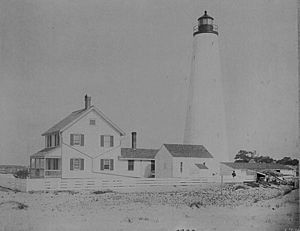Georgetown Light facts for kids
 |
|
|
|
|
| Location | Winyah Bay, South Carolina |
|---|---|
| Coordinates | 33°13′21.47″N 79°11′6.18″W / 33.2226306°N 79.1850500°W |
| Year first constructed | 1801 |
| Year first lit | 1812, rebuilt 1867 |
| Automated | 1986 |
| Foundation | Rubblestone caisson |
| Construction | Brick |
| Tower shape | Conical (nb Light List says "cylindrical") |
| Markings / pattern | White with black lantern |
| Height | 87 feet (27 m) |
| Focal height | 85 feet (26 m) |
| Original lens | 4th order Fresnel (1855) |
| Current lens | VRB-25, Solar Powered |
| Range | 15 nautical miles (28 km; 17 mi) |
| Characteristic | Fl W (2), 15 sec |
| Admiralty number | J2582 |
| ARLHS number | USA-323 |
| USCG number | 3-120 |
The Georgetown Light is a tall, active lighthouse. It stands on North Island, guiding ships into Winyah Bay near Georgetown, South Carolina. This important landmark helps boats find their way safely. The U.S. Coast Guard takes care of the light itself. The lighthouse building is now part of the Tom Yawkey Wildlife Center Heritage Preserve, managed by the State of South Carolina. It is also listed on the National Register of Historic Places, meaning it's a special historical site.
Contents
History of Georgetown Light
Early Beginnings
The very first lighthouse at this spot was built in 1801. It was made from cypress wood. Sadly, a big storm in 1806 destroyed this original tower.
Building a Stronger Lighthouse
After the first lighthouse was lost, a new one was built. In 1812, a stronger brick tower was finished. This new lighthouse stood about 72 feet (22 m) tall. It was designed to withstand tough weather.
Important Upgrades
Over the years, the lighthouse received important updates. In 1857, a special lens called a Fresnel lens was installed. This type of lens was very advanced for its time. It made the light much brighter and easier to see from far away.
Civil War Damage and Rebuilding
During the Civil War, the Georgetown Light suffered some damage. After the war ended, the lighthouse was rebuilt and made even taller. In 1867, its height was increased to 87 feet (27 m). This made its light visible from an even greater distance.
Modern Automation
For many years, lighthouse keepers lived and worked at the Georgetown Light. They made sure the light was always shining. However, in 1986, the lighthouse became automated. This means machines now control the light, so human keepers are no longer needed. The light's main beam shines from 85 feet (26 m) above the average high water level.


